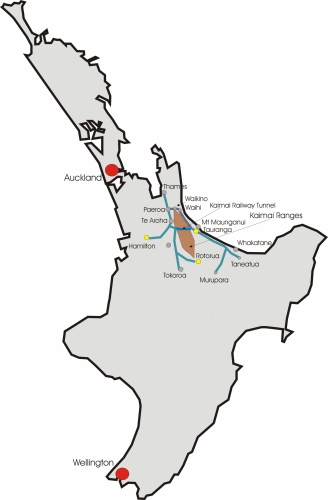The East Coast Main Trunk Railway is a railway line in the North Island of New Zealand, originally running between Hamilton and Taneatua via Tauranga, connecting the Waikato with the Bay of Plenty. The ECMT now runs between Hamilton and Kawerau, with a branch line to Taneatua from the junction at Hawkens. The line is built to narrow gauge of 1067 mm (3 ft 6 in), the uniform gauge in New Zealand.
In 1880, the North Island Main Trunk Railway had reached Frankton, Hamilton, from Auckland. From there, the line made its way to Morrinsville in October 1884, Te Aroha in March 1886 and Paeroa in 1898. The route to Waihi through the Karangahake Gorge was surveyed in the next few years with construction starting in 1900, with three bridges, including a road-rail bridge and a kilometre-long tunnel, which has a 1:50 grade and took three years to build, being completed in 1904. The line between Paeroa and Waihi opened in November 1905. Surveys were undertaken for the route beyond Waihi in 1907 and construction started in March 1912, but was suspended in November of the same year. The work started again in 1914, but was suspended again in March 1917 because of a shortage of staff due to World War I. The works started again in 1918, and the railway through the Athenree Gorge opened to Tahawai in 1925 and Tauranga in March 1925. The remaining length of line to Te Puke, Whakatane and Taneatua opened in 1928.
Originally, the railway line was to run to Opotiki and through the Waioeka Gorge to Gisborne, linking with the Palmerston North - Gisborne Line. Work did begin, however due to two World Wars, an economic depression and an influenza epidemic, the railway was never completed.
The Kaimai Railway Tunnel runs for 8896 m under the Kaimai Ranges, making it the longest tunnel in the Southern Hemisphere. Construction started from both sides of the range in 1969: the headings met in 1976 and the tunnel opened on 12 September 1978.
After the opening of the Kaimai Tunnel, the route through the Karangahake Gorge to the eastern junction closed in 1978 and was dismantled in the 1980s. The railway from Morrinsville to Paeroa stayed open and continued (via the Thames Branch) to Thames until closure in 1991 and lifting in 1996/1997. The rail bridge at Te Aroha is now a walkway over the Waihou River; the route from the tunnel to Waikino through the Karangahake Gorge is now a walkway; from Waikino to Waihi the Goldfields Railway heritage line preserves the old railway; and State Highway 2 runs through the Athrenee Gorge along part of the original rail alignment.





